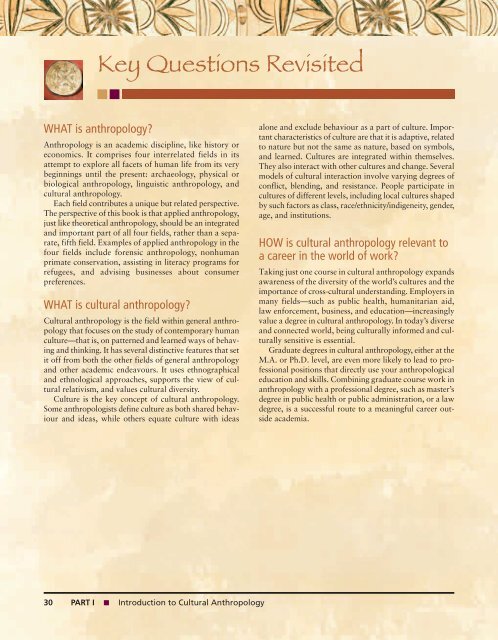PART Introduction to Cultural Anthropology - Pearson Canada
PART Introduction to Cultural Anthropology - Pearson Canada
PART Introduction to Cultural Anthropology - Pearson Canada
Create successful ePaper yourself
Turn your PDF publications into a flip-book with our unique Google optimized e-Paper software.
Key Questions Revisited<br />
WHAT is anthropology?<br />
<strong>Anthropology</strong> is an academic discipline, like his<strong>to</strong>ry or<br />
economics. It comprises four interrelated fields in its<br />
attempt <strong>to</strong> explore all facets of human life from its very<br />
beginnings until the present: archaeology, physical or<br />
biological anthropology, linguistic anthropology, and<br />
cultural anthropology.<br />
Each field contributes a unique but related perspective.<br />
The perspective of this book is that applied anthropology,<br />
just like theoretical anthropology, should be an integrated<br />
and important part of all four fields, rather than a separate,<br />
fifth field. Examples of applied anthropology in the<br />
four fields include forensic anthropology, nonhuman<br />
primate conservation, assisting in literacy programs for<br />
refugees, and advising businesses about consumer<br />
preferences.<br />
WHAT is cultural anthropology?<br />
<strong>Cultural</strong> anthropology is the field within general anthropology<br />
that focuses on the study of contemporary human<br />
culture—that is, on patterned and learned ways of behaving<br />
and thinking. It has several distinctive features that set<br />
it off from both the other fields of general anthropology<br />
and other academic endeavours. It uses ethnographical<br />
and ethnological approaches, supports the view of cultural<br />
relativism, and values cultural diversity.<br />
Culture is the key concept of cultural anthropology.<br />
Some anthropologists define culture as both shared behaviour<br />
and ideas, while others equate culture with ideas<br />
alone and exclude behaviour as a part of culture. Important<br />
characteristics of culture are that it is adaptive, related<br />
<strong>to</strong> nature but not the same as nature, based on symbols,<br />
and learned. Cultures are integrated within themselves.<br />
They also interact with other cultures and change. Several<br />
models of cultural interaction involve varying degrees of<br />
conflict, blending, and resistance. People participate in<br />
cultures of different levels, including local cultures shaped<br />
by such fac<strong>to</strong>rs as class, race/ethnicity/indigeneity, gender,<br />
age, and institutions.<br />
HOW is cultural anthropology relevant <strong>to</strong><br />
a career in the world of work?<br />
Taking just one course in cultural anthropology expands<br />
awareness of the diversity of the world’s cultures and the<br />
importance of cross-cultural understanding. Employers in<br />
many fields—such as public health, humanitarian aid,<br />
law enforcement, business, and education—increasingly<br />
value a degree in cultural anthropology. In <strong>to</strong>day’s diverse<br />
and connected world, being culturally informed and culturally<br />
sensitive is essential.<br />
Graduate degrees in cultural anthropology, either at the<br />
M.A. or Ph.D. level, are even more likely <strong>to</strong> lead <strong>to</strong> professional<br />
positions that directly use your anthropological<br />
education and skills. Combining graduate course work in<br />
anthropology with a professional degree, such as master’s<br />
degree in public health or public administration, or a law<br />
degree, is a successful route <strong>to</strong> a meaningful career outside<br />
academia.<br />
30 <strong>PART</strong> I ■ <strong>Introduction</strong> <strong>to</strong> <strong>Cultural</strong> <strong>Anthropology</strong>
















